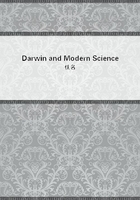
第205章
"Je dus, en me livrant a ces recherches, suivre ligne par ligne les divers chapitres des "Observations geologiques" consacrees aux iles de l'Atlantique, oblige que j'etais de comparer d'une maniere suivie les resultats auxquels j'etais conduit avec ceux de Darwin, qui servaient de controle a mes constatations. Je ne tardai pas a eprouver une vive admiration pour ce chercheur qui, sans autre appareil que la loupe, sans autre reaction que quelques essais pyrognostiques, plus rarement quelques mesures au goniometre, parvenait a discerner la nature des agregats mineralogiques les plue complexes et les plus varies. Ce coup d'oeil qui savait embrasser de si vastes horizons, penetre ici profondement tous les details lithologiques. Avec quelle surete et quelle exactitude la structure et la composition des roches ne sont'elles pas determinees, l'origne de ces masses minerales deduite et confirmee par l'etude comparee des manifestations volcaniques d'autres regions; avec quelle science les relations entre les faits qu'il decouvre et ceux signales ailleurs par ses devanciers ne sont'elles pas etablies, et comme voici ebranlees les hypotheses regnantes, admises sans preuves, celles, par exemple, des crateres de soulevement et de la differenciation radicale des phenomenes plutoniques et volcaniques! Ce qui acheve de donner a ce livre un incomparable merite, ce sont les idees nouvelles qui s'y trouvent en germe et jetees la comme au hasard ainsi qu'un superflu d'abondance intellectuelle inepuisable." ("Observations Geologiques sur les Iles Volcaniques...", Paris, 1902, pages vi., vii.)While engaged in his study of banded lavas, Darwin was struck with the analogy of their structure with that of glacier ice, and a note on the subject, in the form of a letter addressed to Professor J.D. Forbes, was published in the "Proceedings of the Royal Society of Edinburgh". (Vol.
II. (1844-5), pages 17, 18.)
From April, 1832, to September, 1835, Darwin had been occupied in examining the coast or making inland journeys in the interior of the South American continent. Thus while eighteen months were devoted, at the beginning and end of the voyage to the study of volcanic islands and coral-reefs, no less than three and a half years were given to South American geology. The heavy task of dealing with the notes and specimens accumulated during that long period was left by Darwin to the last. Finishing the "Volcanic Islands" on February 14th, 1844, he, in July of the same year, commenced the preparation of two important works which engaged him till near the end of the year 1846. The first was his "Geological Observations on South America", the second a recast of his "Journal", published under the short title of "A Naturalist's Voyage round the World".
The first of these works contains an immense amount of information collected by the author under great difficulties and not unfrequently at considerable risk to life and health. No sooner had Darwin landed in South America than two sets of phenomena powerfully arrested his attention. The first of these was the occurrence of great masses of red mud containing bones and shells, which afforded striking evidence that the whole continent had shared in a series of slow and gradual but often interrupted movements.
The second related to the great masses of crystalline rocks which, underlying the muds, cover so great a part of the continent. Darwin, almost as soon as he landed, was struck by the circumstance that the direction, as shown by his compass, of the prominent features of these great crystalline rock-masses--their cleavage, master-joints, foliation and pegmatite veins--was the same as the orientation described by Humboldt (whose works he had so carefully studied) on the west of the same great continent.
The first five chapters of the book on South America were devoted to formations of recent date and to the evidence collected on the east and west coasts of the continent in regard to those grand earth-movements, some of which could be shown to have been accompanied by earthquake-shocks. The fossil bones, which had given him the first hint concerning the mutability of species, had by this time been studied and described by comparative anatomists, and Darwin was able to elaborate much more fully the important conclusion that the existing fauna of South America has a close analogy with that of the period immediately preceding our own.
The remaining three chapters of the book dealt with the metamorphic and plutonic rocks, and in them Darwin announced his important conclusions concerning the relations of cleavage and foliation, and on the close analogy of the latter structure with the banding found in rock-masses of igneous origin. With respect to the first of these conclusions, he received the powerful support of Daniel Sharpe, who in the years 1852 and 1854 published two papers on the structure of the Scottish Highlands, supplying striking confirmation of the correctness of Darwin's views.
Although Darwin's and Sharpe's conclusions were contested by Murchison and other geologists, they are now universally accepted. In his theory concerning the origin of foliation, Darwin had been to some extent anticipated by Scrope, but he supplied many facts and illustrations leading to the gradual acceptance of a doctrine which, when first enunciated, was treated with neglect, if not with contempt.
The whole of this volume on South American geology is crowded with the records of patient observations and suggestions of the greatest value; but, as Darwin himself saw, it was a book for the working geologist and "caviare to the general." Its author, indeed, frequently expressed his sense of the "dryness" of the book; he even says "I long hesitated whether I would publish it or not," and he wrote to Leonard Horner "I am astonished that you should have had the courage to go right through my book." ("M.L." II. page 221.)